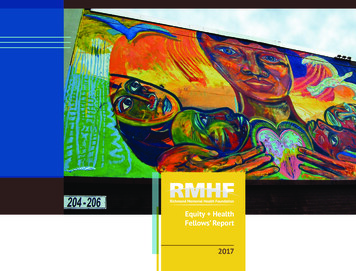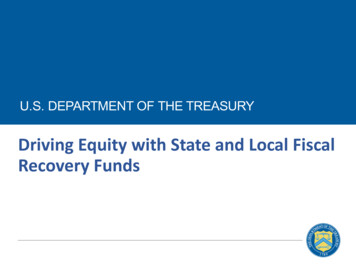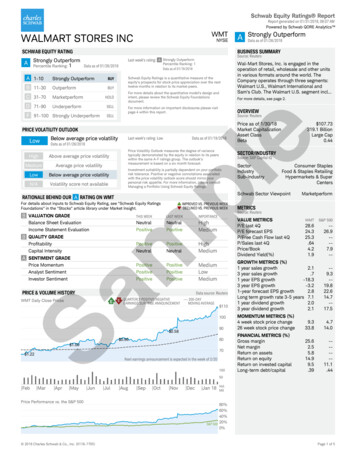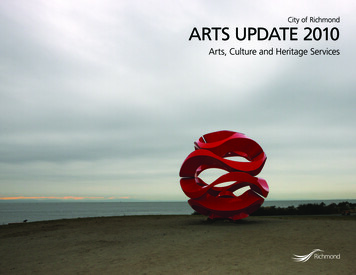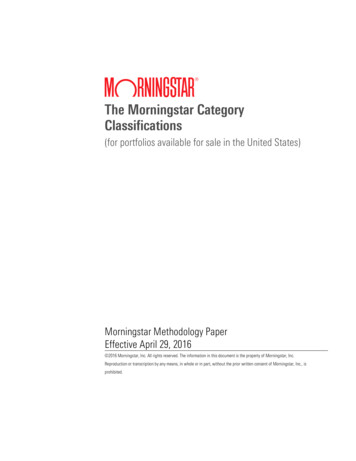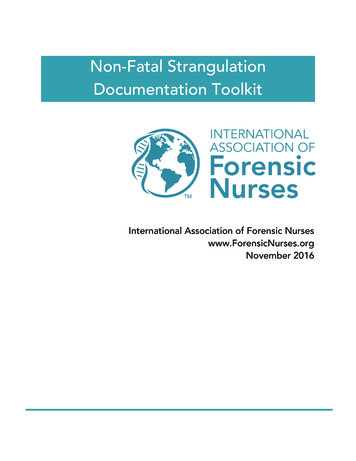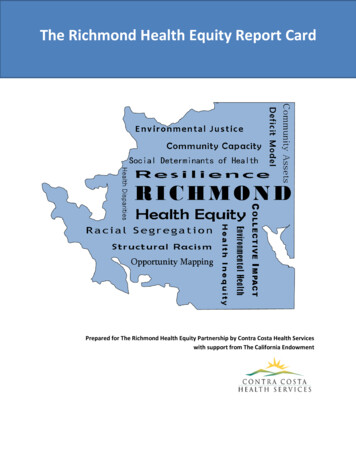
Transcription
The Richmond Health Equity Report CardPrepared for The Richmond Health Equity Partnership by Contra Costa Health Serviceswith support from The California Endowment
The Richmond Health Equity Partnership was created to bring together various stakeholders andagencies committed to improving the health of the people of Richmond. This included the City ofRichmond, the West County Unified School District, and Contra Costa Health Services. An alignment ofefforts across agencies with a unified goal of eliminating health inequities can improve the wellbeing,quality of life, and life expectancy for those who live and work in the city of Richmond. The purpose ofthis report is to present indicators relevant to health and health outcomes to inform programs andpolicies in Richmond.The health of a community is driven by many factors, including the health behaviors of individuals,access to healthcare, but also the environment and social structure of the community. Health equity isdefined as differences in health outcomes that are driven by social injustice. Health differences can bedriven by many factors, including genetics, but when we state that a health difference is an inequity, weare defining that difference as a result of social injustice and that equitable treatment of the affectedcommunity should eliminate that difference. Health equity issues are broader than just the business ofhealth and are driven by economic opportunity, quality education, community environment, andsystemic racism and social prejudice.I
The Health Equity Report Card was created with an attention to the systems and environment that leadto health inequities. In this report we identify populations of concern and key indictors which can beused to measure progress toward health equity in the City. The report is divided into seven sections.Each section contains data from a variety of sources and that data is broken down into racial/ethniccategories or income categories when available. We are limited by the data available, but have providedthe most detailed analysis possible for the chosen indicators. When local data is not available, ContraCosta or Bay Area data is presented. Racial and ethnic breakdowns are provided as a means ofillustrating the effect of social prejudice and racism on health indicators, these breakdowns are notrepresentative of biological or genetically relevant distinctions. It is both the difference in opportunityand fair treatment, but also the stress of institutional racism that drives worse health outcomes inmarginalized populations.Key FindingsEconomic Security and EducationoooooooFemale headed households suffer disproportionately from poverty.Hispanic/Latino families have the highest poverty rate in Richmond and that rate has beenincreasing.Less educated residents are more likely to live in poverty.African American residents are less likely to participate in the labor force.The median earnings in Richmond are inadequate to support families with one adult andmultiple children.Hispanics/Latinos have the lower educational attainment then other residents.Graduation rates are similar across ethnic groups, but post-secondary enrollment is lowestamong Hispanic/Latino and socioeconomically disadvantaged graduates.Full Service and Safe CommunitiesoooooViolent crime rates and perceptions of violence are decreasing among residents.Lower income communities in Richmond have lower voter turnout than higher incomecommunities.White residents report having greater contact with their neighbors than residents of otherrace/ethnic groups.White students report feeling more safe in school while Asian students report bullying due torace.High poverty households are less prepared for disasters.Residential and Built EnvironmentoooMany communities in Richmond lack access to stores with fresh fruits and vegetables.Half of Richmond stores that sell tobacco are within 1,000 feet of a school.Most Richmond residents live within a quarter mile of a park.II
oooooSome low income communities in Richmond have lower rates of vehicle ownership and lessaccess to public transit.People in lower income communities are more likely to have moved within the past year.Racial isolation has increased for Hispanics/Latinos in Richmond in recent years.Concentrated poverty has increased in recent years.Lower income home owners in Richmond are less likely to be housing cost burdened than lowerincome renters.Environmental Health and JusticeooDiesel particular matter emissions are higher in Richmond than in other neighboring cities inWest Contra Costa County.Lower income communities experience a greater burden of hazardous materials contaminatedclean-up sides, hazardous waste facilities and generators, and chemical releases from facilityemissions.Quality and Accessible Health and Social ServicesoooooooMore than half of households receiving public assistance are female headed households withchildren and no male present.More than half of households living in poverty are female headed households with children andno male present.The central and southeast regions of West Contra Costa have less access to primary carephysicians, dentists, and psychiatrists than the northeast region of West Contra Costa.African Americans are more likely to have avoidable hospitalizations than other race/ethnicgroups in Richmond.Hispanics and the unemployed have the lowest access to health insurance.Most childcare centers in Richmond have high immunization rates.Higher poverty individuals are less likely to have recommended cancer screenings.Health BehaviorsoooooooooAfrican American youth are more likely to be exposed to adults who smoke and AfricanAmerican are more likely to be smokers.Hispanic and African American youth are more likely to consume sugar sweetened beveragesChildren in lower income households are less likely to consume a diet high in fruits andvegetables.Breakfast is a concern for children attending schools in Richmond, as almost a quarter ofstudents surveyed reported not eating anything before school.Food insecurity is a greater concern in African American and Latino/Hispanic populations.Over a third of students surveyed in Richmond schools do not walk or bike to school.Hispanic/Latino students in Richmond schools are at an increased risk for alcohol use.African American students in Richmond schools are at an increased risk for marijuana use.African American students are at an increased risk for unprotected sex.III
Health OutcomesooooooooooooooooooooAsian and Hispanic/Latino residents have the longest life expectancy in Richmond.African Americans have the highest mortality rate in both the younger and older populations.Heart disease, cancer, and stroke are the leading causes of death in Richmond.Heart disease, cancer, and homicide are responsible for the greatest years life lost for Richmondmales.African American males are at a higher risk for cancer incidence.African American and Hispanic/Latino residents experience a greater risk of diabetes diagnosisbut African Americans have the greatest risk of death due to diabetes.African Americans are more likely to be diagnosed with hypertension and have the highestdeath rates due to hypertension, heart disease, and stroke.Richmond has more emergency room and hospitalizations due to asthma than Contra Costa.African Americans are more likely to have been diagnosed with asthma and are much morelikely to visit an emergency room or be hospitalized due to asthma.Young people and African American residents have the highest rates of gonorrhea andchlamydia infections.African Americans in Richmond experience a greater risk of HIV infection than other groupsAlthough male sexual contact is the most common mode of transmission in Richmond,transmission by infection drug use or adult heterosexual contact are more common inRichmond than in Contra Costa.The population of people living with HIV in Richmond is more likely to be older than 40 yearsold than in Contra Costa.There is no longer a difference in preterm or low birthweight births in Richmond compared toContra Costa.Teen births occur more frequently in Richmond than in Contra Costa, but the teen birth rate inRichmond has been declining.Hospitalizations due to alcohol or drug use are most common among White and AfricanAmerican residents in Richmond.Hispanic/Latino students in Richmond experience a greater risk of depression and suicidalthoughts.White adults experience a greater risk of suicidal thoughts and death due to suicide.Low income, Hispanic/Latino, and African American adults experience a greater risk ofpsychological distress.Rates for hospital and emergency visits due to unintentional injury, any intentional injury, andinjury due to a gun are higher for African American residents than other groups in Richmond.IV
efforts across agencies with a unified goal of eliminating health inequities can improve the wellbeing, quality of life, and life expectancy for those who live and work in the city of Richmond. The purpose of this report is to present indicators relevant to health and health outcomes to inform programs and policies in Richmond.



